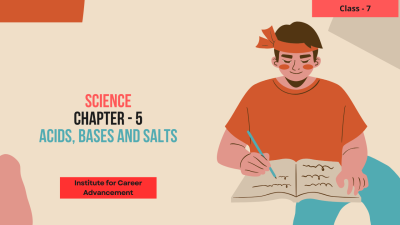| Outcomes |
- In a class 7 course on acids, bases, and salts, the following outcomes are typically aimed for to ensure students gain a comprehensive understanding of these fundamental concepts in chemistry: Knowledge and Understanding: Identify Acids, Bases, and Salts: Students should be able to differentiate between acids (e.g., vinegar), bases (e.g., soap), and salts (e.g., table salt) based on their characteristic properties and behaviors. Properties: Understand the properties of acids (sour taste, turn blue litmus paper red), bases (bitter taste, turn red litmus paper blue), and salts (ionic compound formation). Formation: Explain how salts are formed from the reaction between acids and bases, including the role of ions in the process. Practical Skills: Testing and Observing: Perform simple experiments to test substances using indicators such as litmus paper to determine whether they are acidic, basic, or neutral. Handling and Safety: Demonstrate safe handling practices for acids and bases, including understanding the hazards associated with corrosive substances. Applications: Everyday Uses: Recognize and describe common uses of acids, bases, and salts in daily life (e.g., cooking, cleaning, health products). Industrial Applications: Understand how these substances are used in various industrial processes (e.g., manufacturing, agriculture). Critical Thinking and Problem Solving: Predicting Reactions: Predict the outcome of simple chemical reactions involving acids, bases, and salts based on their properties and the principles learned. Analyzing Effects: Evaluate the impact of acids, bases, and salts on materials and living organisms, considering both positive and negative effects. Conceptual Integration: Relating Concepts: Relate the concepts of acids, bases, and salts to other areas of science, such as environmental science (e.g., acid rain) and biology (e.g., pH balance in the body). Interdisciplinary Connections: Understand how these concepts connect to everyday phenomena and other scientific disciplines. Communication and Collaboration: Presenting Findings: Communicate findings from experiments or research on acids, bases, and salts effectively, using appropriate scientific language. Collaborative Learning: Work collaboratively in groups to solve problems or conduct experiments related to acids, bases, and salts, fostering teamwork and shared learning.
- অ্যাসিড, বেস এবং লবণের উপর ক্লাস 7 কোর্সে, নিম্নলিখিত ফলাফলগুলি সাধারণত লক্ষ্য করা হয় যাতে ছাত্ররা রসায়নের এই মৌলিক ধারণাগুলির একটি বিস্তৃত ধারণা লাভ করে তা নিশ্চিত করার জন্য: জ্ঞান এবং বোঝা: অ্যাসিড, বেস এবং লবণ সনাক্ত করুন: ছাত্রদের তাদের বৈশিষ্ট্য এবং আচরণের উপর ভিত্তি করে অ্যাসিড (যেমন, ভিনেগার), বেস (যেমন, সাবান) এবং লবণের (যেমন, টেবিল লবণ) মধ্যে পার্থক্য করতে সক্ষম হওয়া উচিত। বৈশিষ্ট্য: অ্যাসিডের বৈশিষ্ট্য (টক স্বাদ, নীল লিটমাস কাগজ লাল), ঘাঁটি (তিক্ত স্বাদ, লাল লিটমাস কাগজ নীল), এবং লবণ (আয়নিক যৌগ গঠন) বুঝুন। গঠন: প্রক্রিয়ায় আয়নগুলির ভূমিকা সহ অ্যাসিড এবং ঘাঁটির মধ্যে বিক্রিয়া থেকে কীভাবে লবণ তৈরি হয় তা ব্যাখ্যা করুন। ব্যবহারিক দক্ষতা: পরীক্ষা এবং পর্যবেক্ষণ: পদার্থগুলি অম্লীয়, মৌলিক বা নিরপেক্ষ কিনা তা নির্ধারণ করতে লিটমাস পেপারের মতো সূচকগুলি ব্যবহার করে পরীক্ষা করার জন্য সাধারণ পরীক্ষাগুলি সম্পাদন করুন। হ্যান্ডলিং এবং নিরাপত্তা: ক্ষয়কারী পদার্থের সাথে সম্পর্কিত বিপদগুলি বোঝা সহ অ্যাসিড এবং ঘাঁটির জন্য নিরাপদ হ্যান্ডলিং অনুশীলনগুলি প্রদর্শন করুন। অ্যাপ্লিকেশন: দৈনন্দিন ব্যবহার: দৈনন্দিন জীবনে অ্যাসিড, বেস এবং লবণের সাধারণ ব্যবহারগুলি চিনুন এবং বর্ণনা করুন (যেমন, রান্না, পরিষ্কার, স্বাস্থ্য পণ্য)। শিল্প প্রয়োগ: বিভিন্ন শিল্প প্রক্রিয়ায় (যেমন, উৎপাদন, কৃষি) এই পদার্থগুলি কীভাবে ব্যবহার করা হয় তা বুঝুন। সমালোচনামূলক চিন্তাভাবনা এবং সমস্যা সমাধান: ভবিষ্যদ্বাণীমূলক প্রতিক্রিয়া: অ্যাসিড, বেস এবং লবণ জড়িত সাধারণ রাসায়নিক বিক্রিয়ার ফলাফলের ভবিষ্যদ্বাণী করুন তাদের বৈশিষ্ট্য এবং শেখা নীতিগুলির উপর ভিত্তি করে। প্রভাব বিশ্লেষণ: ইতিবাচক এবং নেতিবাচক উভয় প্রভাব বিবেচনা করে পদার্থ এবং জীবন্ত প্রাণীর উপর অ্যাসিড, বেস এবং লবণের প্রভাব মূল্যায়ন করুন। ধারণাগত একীকরণ: সম্পর্কিত ধারণা: অ্যাসিড, বেস এবং লবণের ধারণাগুলিকে বিজ্ঞানের অন্যান্য ক্ষেত্রের সাথে সম্পর্কিত করুন, যেমন পরিবেশ বিজ্ঞান (যেমন, অ্যাসিড বৃষ্টি) এবং জীববিদ্যা (যেমন, শরীরে পিএইচ ভারসাম্য)। আন্তঃবিভাগীয় সংযোগ: এই ধারণাগুলি দৈনন্দিন ঘটনা এবং অন্যান্য বৈজ্ঞানিক শাখার সাথে কীভাবে সংযোগ করে তা বুঝুন। যোগাযোগ এবং সহযোগিতা: উপস্থাপিত ফলাফল: যথাযথ বৈজ্ঞানিক ভাষা ব্যবহার করে কার্যকরভাবে অ্যাসিড, বেস এবং লবণের উপর পরীক্ষা বা গবেষণার ফলাফলগুলিকে যোগাযোগ করুন। সহযোগিতামূলক শিক্ষা: সমস্যাগুলি সমাধান করতে বা অ্যাসিড, বেস এবং লবণ সম্পর্কিত পরীক্ষাগুলি পরিচালনা করতে, দলগত কাজ এবং ভাগ করা শিক্ষাকে উত্সাহিত করার জন্য যৌথভাবে কাজ করুন।
|
|
|


 0
0 